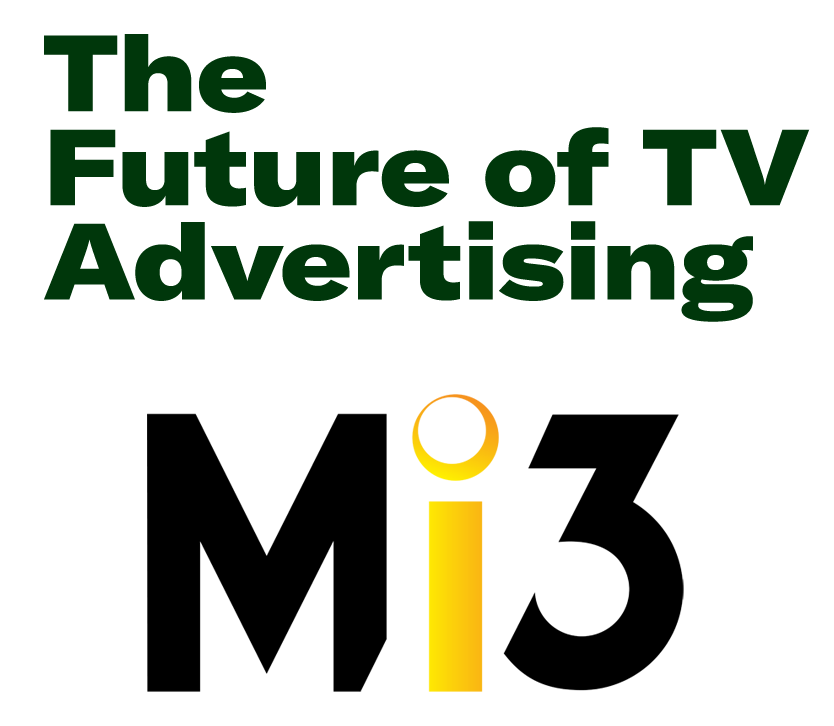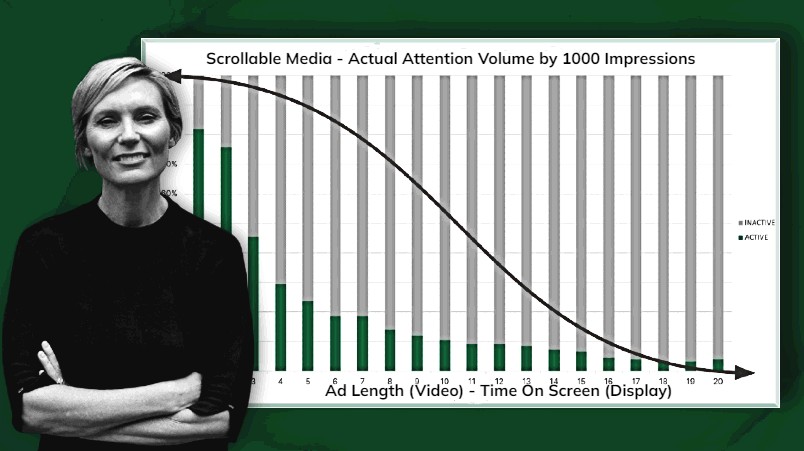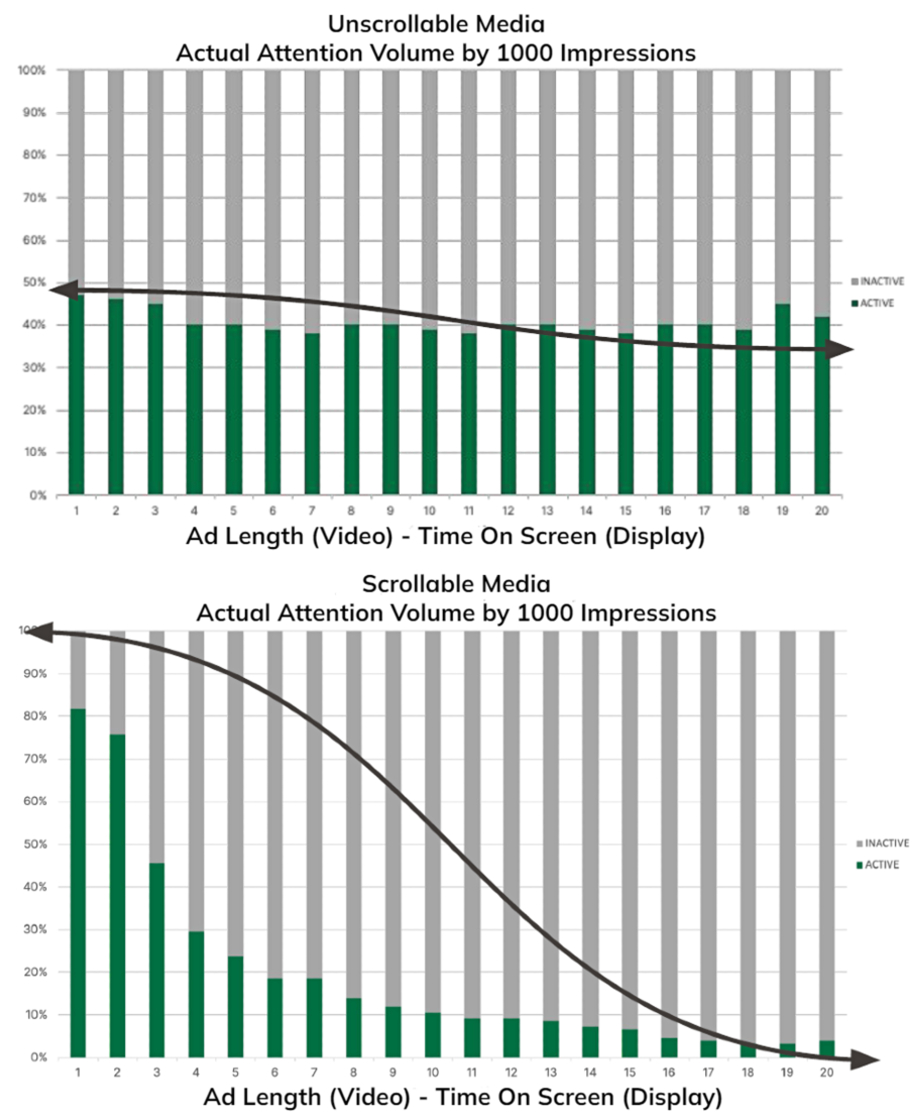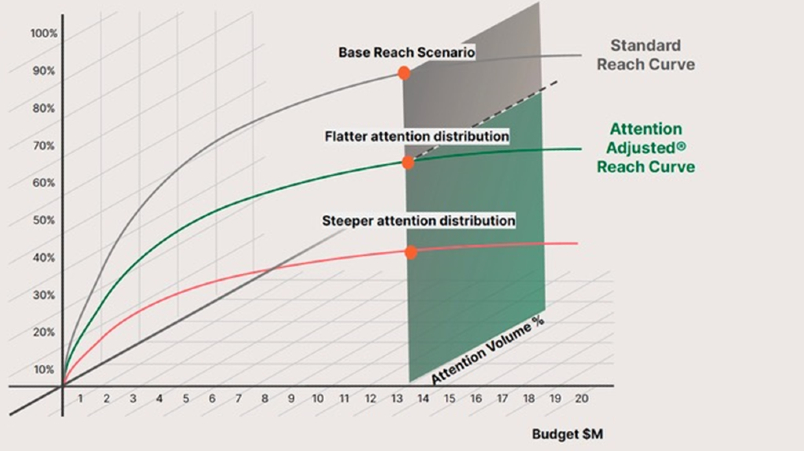‘Reach curves have gone rogue’: Karen Nelson-Field warns ‘scrollable media’ attention decay cuts audience reach volumes by up to 70%; socials, websites, publishing hit along with brand growth
An Mi3 editorial series brought to you by
The Future of TV Advertising Forum and Mi3


Karen Nelson-Field: "When attention is fleeting, your assets, particularly distinctive assets, don’t land. This makes a massive difference to brand growth."
A month after P&G’s Global Chief Brand Officer Marc Pritchard outlined the consumer goods giant’s increasing focus on reaching 90-100 per cent of a given target audience for its ad campaigns, Amplified Intelligence’s Karen Nelson-Field released new analysis at the Future of TV Advertising forum in Sydney yesterday showing the marked decay in consumer attention between scrollable and non-scrollable media platforms. Ultimately it undermines the ‘theoretical’ assumptions made by advertisers, agencies and media in their audience reach planning.
So what happens is by the time you get to the first brand impression, half of the reach that you've paid for has actually already scrolled away
Fight the rogues
Advertising attention proponent Karen Nelson-Field told a packed video and TV screen conference in Sydney yesterday that “reach curves have gone rogue”, imploding assumptions by advertisers, agencies and media that audience reach targets actually deliver the volumes set in their media plans. The new data builds on earlier work from Amplified Intelligence which argues baseline ad attention levels are vastly different depending on the media channel or platform.
Scrollable media – mostly social platforms, websites and text-based publishing – show dramatic drops in “actual attention” after two seconds for video ads and time-on-screen for text-based website views.
Conversely, unscrollable media – video and large screen TVs – showed largely unchanged attention decay after 20 seconds.
Nelson-Field told Mi3 there was important nuance and exceptions buried in the data – floating display ads for websites and even Facebook Watch – were examples where attention did not decay as quickly.
But ultimately, Nelson-Field said the analysis meant most audience reach planning is theoretical and flawed because it assumes advertisers were landing all or most of their audience volume targets.
When asked about the reach ambitions stated by P&G's Global Chief Brand Officer, Marc Pritchard, at the American National Advertisers (ANA) media conference last month, she said: "As long as he understands the metrics he's striving for on reach is not really reach, then good on him. It’s a great objective but 90-100 per cent of what? There's an impasse between theoretical reach, reach-based planning and the reality."

Distraction is normal
“Distraction is normal even on TV,” she said. “But the shape of this distraction makes the biggest difference to platform effectiveness. It's important largely because of the impact on reach based planning. What most people expect when you're planning for reach in your existing reach curves, your current workflows and planning is they assume that every second that someone's watching something or consuming a media type, that for that entire course of the view, 100 per cent of the people are watching at 100 per cent active attention. That's how your systems roll, right – that's history.
“But each particular media type has a different [ad attention] distribution curve. And this is the issue we face with media planning.”
Beyond the differing baseline ad attention levels that each media channel or platform delivers, which put the Adelaide-based Amplified Intelligence on the global stage, the latest work divides the advertising world in two: scrollable media and unscrollable media. Attention decay is a particular issue in unscrollable media, Nelson-Field said.
“When decay is flat, it means that people are paying the same amount of attention across the entire course of your ad. This makes a massive difference to brand growth because when attention is fleeting, your assets, particularly distinctive assets, are at risk.”
Nelson-Field showed charts presenting the differences between scrollable and unscollable media.
Reach wastage
“Putting a longer ad on a highly scrollable format will be wastage full stop. And that's because of this fast decay versus slow decay. The other thing that's interesting is, generally speaking now, there are many reasons for brand growth – but in this context when people scroll fast, it actually impacts negatively on the exposure from the brand itself. So what happens is by the time you get to the first brand impression, half of the reach that you've paid for has actually already scrolled away. By the time you get to second 20, you've only got 5-10 per cent that's even looking.”
The new research continues the split on audience reach strategies between Nelson-Field and the Ehrenberg-Bass Institute’s Professor Byron Sharp, who has downplayed the need for attention-based reach measurement. Reach is reach, he argues.
But in a recent piece for WARC, Nelson-Field wrote: “The point here is that while I agree reach is valuable to brand growth, error significantly reduces the ability for reach-based planning to even work. You might buy a million impressions, your competitor might buy a million impressions but the volume of human attention achieved could be very different in each case. This has significant implications on the ability to deliver on objectives like mental availability or the ability to use share-of-voice budget planning. Any concept, model or relationship that relies on equitable impressions is at risk of failure.”

Nelson-Field cited some recent attention analysis for a brand in Saudi Arabia which discovered its creative messages appearing in scrollable media were missing its brand exposure entirely because it was not early enough in the ad.
“Their ad was on the socials or on the high scrolls where the brand showed up right at the end,” she said. “So what happens is their ads are actually quite beautiful and they were getting lots of attention to a point. When I say lots, I think it was like four seconds. But the actual brand was last and really, really late – so it was being misattributed to their larger competitor. This is why it has negative impacts on brand growth. If you've got flatter [ad attention decay] distribution, it doesn't happen that way.”
She also cited another piece of analysis of 1,000 ads from Amplified’s global database plotting what was “normal” when branded moments first showed up in an ad. “What we can see is that in the open web, about 80 per cent of the time the ad itself or the logo or the branded moment fell under 20 per cent [of the audience paying attention to the ad],” she said.
